您好,登錄后才能下訂單哦!
您好,登錄后才能下訂單哦!
這期內容當中小編將會給大家帶來有關Python中怎么創建一個瀑布圖,文章內容豐富且以專業的角度為大家分析和敘述,閱讀完這篇文章希望大家可以有所收獲。
創建圖表
首先,執行標準的輸入,并確保IPython能顯示matplot圖。
import numpy as np import pandas as pd import matplotlib.pyplot as plt
%matplotlib inline
設置我們想畫出瀑布圖的數據,并將其加載到數據幀(DataFrame)中。
數據需要以你的起始值開始,但是你需要給出最終的總數。我們將在下面計算它。
index = ['sales','returns','credit fees','rebates','late charges','shipping'] data = {'amount': [350000,-30000,-7500,-25000,95000,-7000]} trans = pd.DataFrame(data=data,index=index)我使用了IPython中便捷的display函數來更簡單地控制我要顯示的內容。
from IPython.display import display
display(trans)
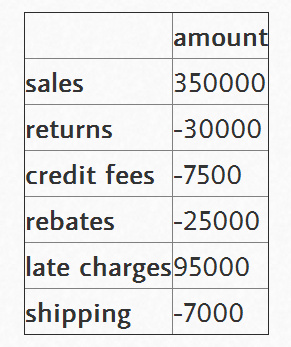
瀑布圖的***技巧是計算出底部堆疊條形圖的內容。有關這一點,我從stackoverflow上的討論中學到很多。
首先,我們得到累積和。
display(trans.amount.cumsum()) sales 350000 returns 320000 credit fees 312500 rebates 287500 late charges 382500 shipping 375500 Name: amount, dtype: int64
這看起來不錯,但我們需要將一個地方的數據轉移到右邊。
blank=trans.amount.cumsum().shift(1).fillna(0)
display(blank)
sales 0 returns 350000 credit fees 320000 rebates 312500 late charges 287500 shipping 382500 Name: amount, dtype: float64
我們需要向trans和blank數據幀中添加一個凈總量。
total = trans.sum().amount trans.loc["net"] = total blank.loc["net"] = total display(trans) display(blank)
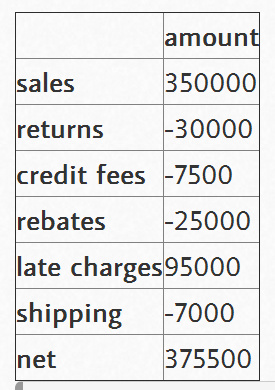
sales 0 returns 350000 credit fees 320000 rebates 312500 late charges 287500 shipping 382500 net 375500 Name: amount, dtype: float64
創建我們用來顯示變化的步驟。
step = blank.reset_index(drop=True).repeat(3).shift(-1)
step[1::3] = np.nan
display(step)
0 0 0 NaN 0 350000 1 350000 1 NaN 1 320000 2 320000 2 NaN 2 312500 3 312500 3 NaN 3 287500 4 287500 4 NaN 4 382500 5 382500 5 NaN 5 375500 6 375500 6 NaN 6 NaN Name: amount, dtype: float64
對于“net”行,為了不使堆疊加倍,我們需要確保blank值為0。
blank.loc["net"] = 0
然后,將其畫圖,看一下什么樣子。
my_plot = trans.plot(kind='bar', stacked=True, bottom=blank,legend=None, title="2014 Sales Waterfall")
my_plot.plot(step.index, step.values,'k')
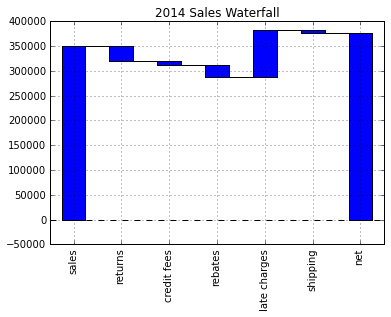
看起來相當不錯,但是讓我們試著格式化Y軸,以使其更具有可讀性。為此,我們使用FuncFormatter和一些Python2.7+的語法來截斷小數并向格式中添加一個逗號。
def money(x, pos):
'The two args are the value and tick position'
return "${:,.0f}".format(x)
from matplotlib.ticker import FuncFormatter formatter = FuncFormatter(money)
然后,將其組合在一起。
my_plot = trans.plot(kind='bar', stacked=True, bottom=blank,legend=None, title="2014 Sales Waterfall")
my_plot.plot(step.index, step.values,'k')
my_plot.set_xlabel("Transaction Types")
my_plot.yaxis.set_major_formatter(formatter)
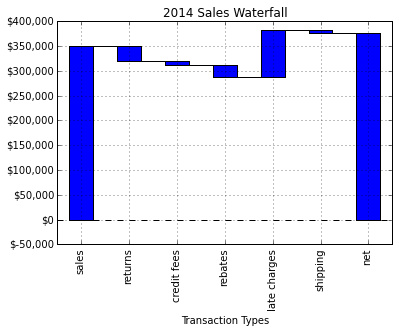
完整腳本
基本圖形能夠正常工作,但是我想添加一些標簽,并做一些小的格式修改。下面是我最終的腳本:
import numpy as np import pandas as pd import matplotlib.pyplot as plt from matplotlib.ticker import FuncFormatter #Use python 2.7+ syntax to format currency def money(x, pos): 'The two args are the value and tick position' return "${:,.0f}".format(x) formatter = FuncFormatter(money) #Data to plot. Do not include a total, it will be calculated index = ['sales','returns','credit fees','rebates','late charges','shipping'] data = {'amount': [350000,-30000,-7500,-25000,95000,-7000]} #Store data and create a blank series to use for the waterfall trans = pd.DataFrame(data=data,index=index) blank = trans.amount.cumsum().shift(1).fillna(0) #Get the net total number for the final element in the waterfall total = trans.sum().amount trans.loc["net"]= total blank.loc["net"] = total #The steps graphically show the levels as well as used for label placement step = blank.reset_index(drop=True).repeat(3).shift(-1) step[1::3] = np.nan #When plotting the last element, we want to show the full bar, #Set the blank to 0 blank.loc["net"] = 0 #Plot and label my_plot = trans.plot(kind='bar', stacked=True, bottom=blank,legend=None, figsize=(10, 5), title="2014 Sales Waterfall") my_plot.plot(step.index, step.values,'k') my_plot.set_xlabel("Transaction Types") #Format the axis for dollars my_plot.yaxis.set_major_formatter(formatter) #Get the y-axis position for the labels y_height = trans.amount.cumsum().shift(1).fillna(0) #Get an offset so labels don't sit right on top of the bar max = trans.max() neg_offset = max / 25 pos_offset = max / 50 plot_offset = int(max / 15) #Start label loop loop = 0 for index, row in trans.iterrows(): # For the last item in the list, we don't want to double count if row['amount'] == total: y = y_height[loop] else: y = y_height[loop] + row['amount'] # Determine if we want a neg or pos offset if row['amount'] > 0: y += pos_offset else: y -= neg_offset my_plot.annotate("{:,.0f}".format(row['amount']),(loop,y),ha="center") loop+=1 #Scale up the y axis so there is room for the labels my_plot.set_ylim(0,blank.max()+int(plot_offset)) #Rotate the labels my_plot.set_xticklabels(trans.index,rotation=0) my_plot.get_figure().savefig("waterfall.png",dpi=200,bbox_inches='tight')運行該腳本將生成下面這個漂亮的圖表:
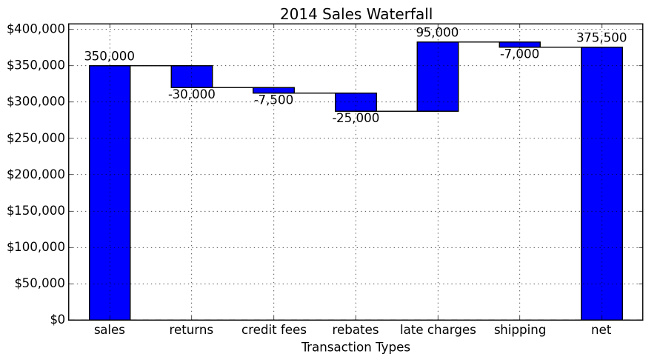
上述就是小編為大家分享的Python中怎么創建一個瀑布圖了,如果剛好有類似的疑惑,不妨參照上述分析進行理解。如果想知道更多相關知識,歡迎關注億速云行業資訊頻道。
免責聲明:本站發布的內容(圖片、視頻和文字)以原創、轉載和分享為主,文章觀點不代表本網站立場,如果涉及侵權請聯系站長郵箱:is@yisu.com進行舉報,并提供相關證據,一經查實,將立刻刪除涉嫌侵權內容。